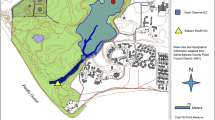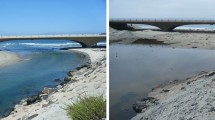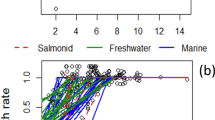Abstract
Human land use activities around estuaries can result in high levels of eutrophication. At Elkhorn Slough estuary, a highly eutrophic California estuary, we investigated the effects of impaired water quality on two stress-tolerant estuarine species, a common fish, the staghorn sculpin, Leptocottus armatus and a foundational invertebrate, the Olympia oyster, Ostrea lurida. We caged the two indicator species at six wetlands with different levels of water quality impairment, four of which had restricted tidal flow. We also recorded water quality parameters simultaneously at all sites using YSI sondes, and sampled nutrients and chlorophyll-a monthly, building on the National Estuarine Research Reserve System-wide Monitoring Program. We found that the monitored environmental variables predicted ecological responses by the indicator species. In particular, we found that the duration and severity of hypoxia were negatively correlated with fish survival and oyster growth. Further, our results corroborate previous studies that artificial tidal restriction leads to increased hypoxia stress. We conclude that large diurnal fluctuations in dissolved oxygen and extended nighttime hypoxia can have lethal and sub-lethal effects even on stress-tolerant organisms in the estuary. While laboratory experiments have often shown such effects, it is relatively rare to demonstrate negative effects of oxygen variation with in situ experiments, which provide stakeholders with concrete evidence for impaired water quality at local wetlands. Tidally restricted sites, which experience the largest fluctuations in dissolved oxygen and longest periods of hypoxia, harbor conditions harmful to vertebrates and invertebrates in the estuary. Reversing the anthropogenically induced low oxygen levels, by restoring more natural tidal exchange and by decreasing agricultural runoff, could improve the survival and growth of important estuarine organisms.





Similar content being viewed by others

Change history
23 February 2017
An erratum to this article has been published.
References
Adams, M. S. 2009. Central Coast Regional Water Quality Control Board. Clean Water Act Sections 305(b) and 303(d) Integrated Report for the Central Coast Region. http://www.waterboards.ca.gov/centralcoast/water_issues/programs/tmdl/303d/2008_0409_draft_integrated_report.pdf. Accessed 2 December 2015.
Baker, P. 1995. Review of ecology and fishery of the Olympia oyster, Ostrea lurida with annotated bibliography. Journal of Shellfish Research 14(2): 501–518.
Beck, N.G., and K.W. Bruland. 2000. Diel biogeochemical cycling in a hyperventilating shallow estuarine environment. Estuaries 23(2): 177–187.
Beck, M.W., K.L. Heck Jr, K.W. Able, D.L. Childers, D.B. Eggleston, B.M. Gillanders, B. Halpern, et al. 2001. The identification, conservation, and management of estuarine and marine nurseries for fish and invertebrates: a better understanding of the habitats that serve as nurseries for marine species and the factors that create site-specific variability in nursery quality will improve conservation and management of these areas. Bioscience 51(8): 633–641.
Burnham, K.P., and D. R. Anderson. 2002. Model selection and multimodel inference: a practical information-theoretic approach. Ecological Modelling. Vol. 172. New York: Springer-Verlag. doi:10.1016/j.ecolmodel.2003.11.004.
Caffrey, J.M., M. Brown, W.B. Tyler, and M. Silberstein. 2002a. Preface p. xi-xii. In Changes in a California estuary: a profile of Elkhorn Slough, eds. J.M. Caffrey, M. Brown, W.B. Tyler, and M. Silberstein. Royal Oaks, California: Elkhorn Slough Foundation.
Caffrey, J.M., N. Harrington, and B. Ward. 2002b. Biogeochemical processes in a small California estuary. 1. Benthic fluxes and pore water constituents reflect high nutrient freshwater inputs. Marine Ecology Progress Series 233: 39–53.
Caffrey, J.M., N. Harrington, I. Solem, and B.B. Ward. 2003. Biogeochemical processes in a small California estuary. 2. Nitrification activity, community structure and role in nitrogen budgets. Marine Ecology Progress Series 248: 27–40.
Caffrey, J.M., T.P. Chapin, H.W. Jannasch, and J.C. Haskins. 2007. High nutrient pulses, tidal mixing and biological response in a small California estuary: variability in nutrient concentrations from decadal to hourly time scales. Estuarine, Coastal and Shelf Science 71(3): 368–380.
Cheng, B.S., J.M. Bible, A.L. Chang, M.D. Ferner, K. Wasson, C.J. Zabin, M. Latta, A. Deck, A.E. Todgham, and E.D. Grosholz. 2015. Testing local and global stressor impacts on a coastal foundation species using an ecologically realistic framework. Global Change Biology. doi:10.1111/gcb.12895.
Clarke, K.R. 1993. Non-parametric multivariate analyses of changes in community structure. Australian Journal of Ecology 18: 117–143.
Clarke, K. R., and R. N. Gorley. 2006. PRIMER v. 6: User manual/tutorial. PRIMER-E. Plymouth, UK.
Cloern, James E. 2001. Our evolving conceptual model of the coastal eutrophication problem. Marine Ecology Progress Series 210: 223–253.
Crain, C.M., K. Kroeker, and B.S. Halpern. 2008. Interactive and cumulative effects of multiple human stressors in marine systems. Ecology Letters 11: 1304–1315. doi:10.1111/j.1461-0248.2008.01253.x.
Cronin, L. E., and A. J. Mansueti. 1971. The biology of the estuary. Maryland: Sport Fishing Institute.
Diaz, R.J., and R. Rosenberg. 1995. Marine benthic hypoxia: a review of its ecological effects and the behavioural responses of benthic macrofauna. Oceanography and Marine Biology: An Annual Review 33: 245–303.
Dıaz, R.J., and R. Rosenberg. 2008. Spreading dead zones and consequences for marine ecosystems. Science 321: 926–929.
Eby, L.A., and L.B. Crowder. 2002. Hypoxia-based habitat compression in the Neuse River Estuary: context-dependent shifts in behavioral avoidance thresholds. Canadian Journal of Fisheries and Aquatic Sciences 59: 952–965. doi:10.1139/F02-067.
Edgar, G.J., N.S. Barrett, D.J. Graddon, and P.R. Last. 2000. The conservation significance of estuaries: a classification of Tasmanian estuaries using ecological, physical and demographic attributes as a case study. Biological Conservation 92(3): 383–397.
Ettinger, A.K., K.R. Ford, and J. Hillerislambers. 2011. Climate determines upper, but not lower, altitudinal range limits of Pacific Northwest conifers. Ecology 92: 1323–1331. doi:10.1890/10-1639.1.
Fitch, J.E., and R.J. Lavenberg. 1975. Tidepool and nearshore fishes of California. California Natural History Guides:38, 156. Berkeley and Los Angeles, California: University of California Press.
Herbert, N.A., and J.F. Steffensen. 2005. The response of Atlantic cod, Gadus morhua, to progressive hypoxia: fish swimming speed and physiological stress. Marine Biology 147(6): 1403–1412.
Hofmann, A.F., E.T. Peltzer, P.M. Walz, and P.G. Brewer. 2011. Hypoxia by degrees: establishing definitions for a changing ocean. Deep Sea Research Part I: Oceanographic Research Papers 58: 1212–1226.
Hughes, B.B., J.C. Haskins, K. Wasson, and E. Watson. 2011. Identifying factors that influence expression of eutrophication in a central California estuary. Marine Ecology Progress Series 439: 31–43.
Hughes, B. B., M. Fountain, A. Carlisle, M. Levey, and M. Gleason. 2012. The impacts of nutrient loading and environmental conditions on the fish assemblage and available nursery habitat in Elkhorn Slough. The Nature Conservancy. http://www.elkhornsloughctp.org/uploads/files/1394826382Hughes%20et%20al%20TNC_Elkhorn-Slough-Fish_Report_FINAL.pdf. Accessed 24 Nov 2015.
Hughes, B.B., R. Eby, E. Van Dyke, M.T. Tinker, C.I. Marks, K.S. Johnson, and K. Wasson. 2013. Recovery of a top predator mediates negative eutrophic effects on seagrass. Proceedings of the National Academy of Sciences 110(38): 15313–15318.
Hughes, B.B., M.D. Levey, M.C. Fountain, A.B. Carlisle, F.P. Chavez, and M.G. Gleason. 2015. Climate mediates hypoxic stress on fish diversity and nursery function at the land-sea interface. Proceedings of the National Academy of Sciences 112(26): 8025–8030.
Kennish, M.J. 2001. Coastal salt marsh systems in the US: a review of anthropogenic impacts. Journal of Coastal Research 17(3): 731–748.
Kildow, J., and L. Pendleton. 2010. Elkhorn Slough restoration policy and economics report. Elkhorn Slough National Estuarine Research Reserve website. http://www.elkhornslough.org/tidalwetland/downloads/Kildow_and_Pendleton_Elkhorn_Slough_Restoration_Policy_and_Economics_report_2010.pdf. Accessed 18 Nov 2015.
Leming, T.D., and W.E. Stuntz. 1984. Zones of coastal hypoxia revealed by satellite scanning have implications for strategic fishing. Nature 310: 136–138.
Levings, C. D. 1980. Benthic biology of a dissolved oxygen deficiency event in Howe Sound, BC. Fjord Oceanography. Springer US:515–522.
Morris, R.W. 1960. Temperature, salinity, and southern limits of three species of Pacific cottid fishes. Limnology and Oceanography 5(2): 175–179.
National Estuarine Research Reserve System (NERRS). 2010. CDMO NERR SWMP data management manual. Date Last Revised: February, 2010 Version 6.3
National Estuarine Research Reserve System (NERRS). 2012. Nutrient and chlorophyll monitoring program and database design. Date Last Revised: January, 2012 Version 1.6
Nixon, S.W. 1995. Coastal marine eutrophication: a definition, social causes, and future concerns. Ophelia 41: 199–219.
R Core Team. R: a language and environment for statistical computing. R. 2016. Foundation for Statistical Computing, Vienna, Austria. Version 3.2.2. http://www.R-project.org/
Rabalais, N.N., W.J. Wiseman, and R.E. Turner. 1994. Comparison of continuous records of near-bottom dissolved oxygen from the hypoxia zone along the Louisiana coast. Estuaries 17(4): 850–861.
Rabalais, N.N., R.E. Turner, and W.J. Wiseman Jr. 2002. Gulf of Mexico hypoxia, AKA" the dead zone. Annual Review of Ecology and Systematics 33: 235–263.
Rabalais, N.N., R.E. Turner, R.J. Díaz, and D. Justić. 2009. Global change and eutrophication of coastal waters. ICES Journal of Marine Science: Journal du Conseil 66(7): 1528–1537.
Rabalais, N.N., R.J. Diaz, L.A. Levin, R.E. Turner, D. Gilbert, and J. Zhang. 2010. Dynamics and distribution of natural and human-caused hypoxia. Biogeosciences 7: 585–619.
Renaud, M.L. 1986. Hypoxia in Louisiana coastal waters during 1983: implications for fisheries. Fishery Bulletin 84(1): 19–26.
Ritter, A.F., K. Wasson, S.I. Lonhart, R.K. Preisler, A. Woolfolk, K.A. Griffith, S. Connors, and K.W. Heiman. 2008. Ecological signatures of anthropogenically altered tidal exchange in estuarine ecosystems. Estuaries and Coasts 31(3): 554–571.
Ross, S.W., D.A. Dalton, S. Kramer, and B.L. Christensen. 2001. Physiological (antioxidant) responses of estuarine fishes to variability in dissolved oxygen. Comparative Biochemistry and Physiology Part C: Toxicology & Pharmacology 130(3): 289–303.
Saiz, Steven G. 2011. Water quality control plan for the central coastal basin. http://www.waterboards.ca.gov/centralcoast/publications_forms/publications/basin_plan/docs/basin_plan_2011.pdf. Accessed 30 Nov 2015.
Turner, R.E., and N.N. Rabalais. 1994. Coastal eutrophication near the Mississippi river delta. Nature 368(6472): 619–621.
Vaquer-Sunyer, R., and C.M. Duarte. 2008. Thresholds of hypoxia for marine biodiversity. Proceedings of the National Academy of Sciences 105(40): 15452–15457.
Vitousek, P.M., J.D. Aber, R.W. Howarth, G.E. Likens, P.A. Matson, D.W. Schindler, W.H. Schlesinger, and D.G. Tilman. 1997. Human alteration of the global nitrogen cycle: sources and consequences. Ecological Applications 7(3): 737–750.
Wagner, S.A. 1990. Response to hypoxia in the staghorn sculpin, (Leptocottus armatus). In Thesis, master of science. Corvallis, Oregon: Oregon State University.
Wasson, K. 2010. Informing Olympia oyster restoration: evaluation of factors that limit populations in a California estuary. Wetlands 30(3): 449–459.
Wasson, K., C. Zabin, J. Bible, S. Briley, E. Ceballos, A. Chang, B. Cheng, A. Deck, T. Grosholz, A. Helms, M. Latta, B. Yednock, D. Zacherl, and M. Ferner. 2015. A guide to Olympia oyster restoration and conservation: environmental conditions and sites that support sustainable populations. Climate Change and Olympia Oysters. http://www.sfbaysubtidal.org/OYSTERGUIDE-FULL-LORES.pdf. Accessed 18 Nov 2015.
Widdows, J., R.I.E. Newell, and R. Mann. 1989. Effects of hypoxia and anoxia on survival, energy metabolism, and feeding of oyster larvae (Crassostrea virginica, Gmelin. The Biological Bulletin 177(1): 154–166.
Yoklavich, M.M., G.M. Cailliet, D.S. Oxman, J.P. Barry, and D.C. Lindquist. 2002. Fishes. In Changes in a California estuary: a profile of Elkhorn Slough, eds. J.M. Caffrey, M. Brown, W.B. Tyler, and M. Silberstein, 163–185. Royal Oaks, California: Elkhorn Slough Foundation.
Acknowledgments
We are extremely grateful to everyone who has participated in and contributed to this research. In particular, we would like to thank staff and volunteers at Elkhorn Slough National Estuarine Research Reserve. C. Endris generously generated Fig. 1. M. Fountain assisted with collecting the fish for the study, and S. Fork provided insightful suggestions. Funding for this research was provided by grant number NA12NOS4200124 from the National Oceanographic and Atmospheric Administration to the Elkhorn Slough Foundation on behalf of the Elkhorn Slough National Estuarine Research Reserve.
Author information
Authors and Affiliations
Corresponding author
Additional information
Communicated by Marianne Holmer
The original version of this article was revised: The first sentence in the Discussion section of the original article was incomplete.
An erratum to this article is available at https://doi.org/10.1007/s12237-017-0222-5.
Rights and permissions
About this article
Cite this article
Jeppesen, R., Rodriguez, M., Rinde, J. et al. Effects of Hypoxia on Fish Survival and Oyster Growth in a Highly Eutrophic Estuary. Estuaries and Coasts 41, 89–98 (2018). https://doi.org/10.1007/s12237-016-0169-y
Received:
Revised:
Accepted:
Published:
Issue Date:
DOI: https://doi.org/10.1007/s12237-016-0169-y



